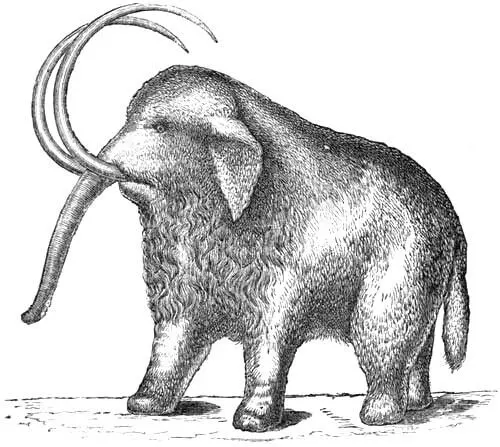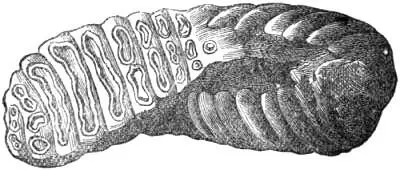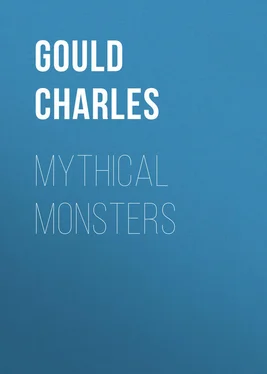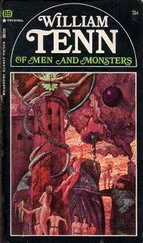Charles Gould - Mythical Monsters
Здесь есть возможность читать онлайн «Charles Gould - Mythical Monsters» — ознакомительный отрывок электронной книги совершенно бесплатно, а после прочтения отрывка купить полную версию. В некоторых случаях можно слушать аудио, скачать через торрент в формате fb2 и присутствует краткое содержание. Жанр: Мифы. Легенды. Эпос, Природа и животные, foreign_antique, foreign_prose, на английском языке. Описание произведения, (предисловие) а так же отзывы посетителей доступны на портале библиотеки ЛибКат.
- Название:Mythical Monsters
- Автор:
- Жанр:
- Год:неизвестен
- ISBN:нет данных
- Рейтинг книги:5 / 5. Голосов: 1
-
Избранное:Добавить в избранное
- Отзывы:
-
Ваша оценка:
- 100
- 1
- 2
- 3
- 4
- 5
Mythical Monsters: краткое содержание, описание и аннотация
Предлагаем к чтению аннотацию, описание, краткое содержание или предисловие (зависит от того, что написал сам автор книги «Mythical Monsters»). Если вы не нашли необходимую информацию о книге — напишите в комментариях, мы постараемся отыскать её.
Mythical Monsters — читать онлайн ознакомительный отрывок
Ниже представлен текст книги, разбитый по страницам. Система сохранения места последней прочитанной страницы, позволяет с удобством читать онлайн бесплатно книгу «Mythical Monsters», без необходимости каждый раз заново искать на чём Вы остановились. Поставьте закладку, и сможете в любой момент перейти на страницу, на которой закончили чтение.
Интервал:
Закладка:
It was by means of these causeways that the large pachyderms entered Britain, then united to the continent; and it was over them they retreated when driven back by glacial conditions, their migration northward being effectually prevented by the destruction of the connecting arms of land.
Some difference of opinion exists among naturalists as to the extent to which zoological regions should be subdivided, and as to their respective limitations.
But Mr. A. R. Wallace, who has most recently written on the subject, is of opinion that the original division proposed by Mr. Sclater in 1857 is the most tenable, and he therefore adopts it in the very exhaustive work upon the geographical distribution of animals which he has recently issued. Mr. Sclater’s Six Regions are as follows: —
1. — The Palæarctic Region , including Europe, Temperate Asia, and North Africa to the Atlas mountains.
2. — The Ethiopian Region , Africa south of the Atlas, Madagascar, and the Mascarene islands, with Southern Arabia.
3. — The Indian Region , including India south of the Himalayas, to South China, and to Borneo and Java.
4. — The Australian Region , including Celebes and Lombok, Eastward to Australia and the Pacific islands.
5. — The Nearctic Region , including Greenland, and North America, to Northern Mexico.
6. — The Neotropical Region , including South America, the Antilles, and Southern Mexico.
This arrangement is based upon a detailed examination of the chief genera and families of birds, and also very nearly represents the distribution of mammals and of reptiles. Its regions are not, as in other subsequently proposed and more artificial systems, controlled by climate; for they range, in some instances, from the pole to the tropics. It probably approaches more nearly than any other yet proposed to that desideratum, a division of the earth into regions, founded on a collation of the groups of forms indigenous to or typical of them, and upon a selection of those peculiar to them; with a disregard of, or only admitting with caution, any which, though common to and apparently establishing connection between two or more regions, may have in fact but little value for the purpose of such comparison; from the fact of its being possible to account for their extended range by their capability of easy transport from one region to another by common natural agencies. 41
Such an arrangement should be consistent with the retrospective information afforded by palæontology; and, taking an extended view of the subject, be not merely a catalogue of the present, but also an index of the past. It should afford an illustration of an existing phase of the distribution of animal life, considered as the last of a long series of similar phases which have successively resulted from changes in the disposition of land and water, and from other controlling agencies, throughout all time. A reconstruction of the areas respectively occupied by the sea and the land at different geological periods will be possible, or at least greatly facilitated, when a complete system of similar groupings, illustrative of each successive period, has been compiled.
It is obvious that any great cosmical change, affecting to a wide extent any of the regions, might determine a destruction of specific existence; and this on a large scale, in comparison with the change which is always progressing in a smaller degree in the different and isolated divisions.
The brief remarks which I have made on this subject are intended to suggest, rather than to demonstrate – which could only be done by a lengthy series of examples – the causes influencing specific existence and its in many cases extreme frailty of tenure. And I shall now conclude by citing from the works of Lyell and Wallace a short list of notable species, now extinct, whose remains have been collected from late Tertiary, and Post Tertiary deposits – that is to say, at a time subsequent to the appearance of man. From other authors I have extracted an enumeration of species which have become locally or entirely extinct within the historic period.
These instances will, I think, be sufficient to show that, as similar destructive causes must have been in action during pre-historic times, it is probable that, besides those remarkable animals of which remains have been discovered, many others which then existed may have perished without leaving any trace of their existence. There is, consequently, a possibility that some at least of the so-called myths respecting extraordinary creatures, hitherto considered fabulous, may merely be distorted accounts — traditions – of species as yet unrecognised by Science, which have actually existed, and that not remotely, as man’s congener.
The Mammoth. – Among other remarkable forms whose remains have been discovered in those later deposits, in which geologists are generally agreed that remains of man or traces of his handicraft have also been recognised, there is one which stands out prominently both for its magnitude and extensive range in time and space. Although the animal itself is now entirely extinct, delineations by the hand of Palæolithic man have been preserved, and even frozen carcases, with the flesh uncorrupted and fit for food, have been occasionally discovered.

Fig. 9. – The Mammoth. ( After Jukes. )
This is the mammoth, the Elephas primigenius of Blumenbach, a gigantic elephant nearly a third taller than the largest modern species, and twice its weight. Its body was protected from the severity of the semi-arctic conditions under which it flourished by a dense covering of reddish wool, and long black hair, and its head was armed or ornamented with tusks exceeding twelve feet in length, and curiously curved into three parts of a circle. Its ivory has long been, and still is, a valuable article of commerce, more especially in North-eastern Asia, and in Eschscholtz Bay in North America, near Behring’s straits, where entire skeletons are occasionally discovered, and where even the nature of its food has been ascertained from the undigested contents of its stomach.
There is a well-known case recorded of a specimen found (1799), frozen and encased in ice, at the mouth of the Lena. It was sixteen feet long, and the flesh was so well preserved that the Yakuts used it as food for their dogs. But similar instances occurred previously, for we find the illustrious savant and Emperor Kang Hi [A.D. 1662 to 1723] penning the following note 42upon what could only have been this species: —
“The cold is extreme, and nearly continuous on the coasts of the northern sea beyond Tai-Tong-Kiang. It is on this coast that the animal called Fen Chou is found, the form of which resembles that of a rat, but which equals an elephant in size. It lives in obscure caverns, and flies from the light. There is obtained from it an ivory as white as that of the elephant, but easier to work, and which will not split. Its flesh is very cold and excellent for refreshing the blood. The ancient work Chin-y-king speaks of this animal in these terms: ‘There is in the depths of the north a rat which weighs as much as a thousand pounds; its flesh is very good for those who are heated.’ The Tsée-Chou calls it Tai-Chou and speaks of another species which is not so large. It says that this is as big as a buffalo, buries itself like a mole, flies the light, and remains nearly always under ground; it is said that it would die if it saw the light of the sun or even that of the moon.”

Fig. 10. – Tooth of the Mammoth. ( After Figuier. )
Читать дальшеИнтервал:
Закладка:
Похожие книги на «Mythical Monsters»
Представляем Вашему вниманию похожие книги на «Mythical Monsters» списком для выбора. Мы отобрали схожую по названию и смыслу литературу в надежде предоставить читателям больше вариантов отыскать новые, интересные, ещё непрочитанные произведения.
Обсуждение, отзывы о книге «Mythical Monsters» и просто собственные мнения читателей. Оставьте ваши комментарии, напишите, что Вы думаете о произведении, его смысле или главных героях. Укажите что конкретно понравилось, а что нет, и почему Вы так считаете.











